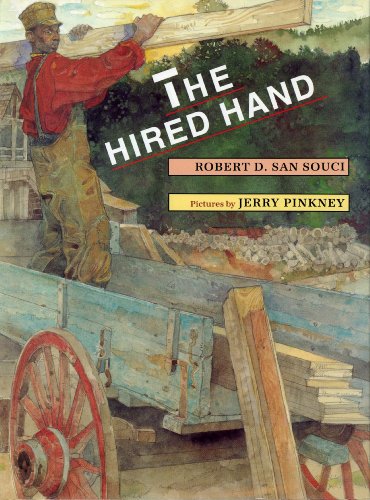Synopsis
Old Sam hires a man to help out at his saw mill, and the hired hand also teaches Sam's lazy son a lesson about how to treat people
Reviews
Kindergarten-Grade 4. The Hired Hand explores the danger associated with stealing someone's magic. It echoes this talented team's collaboration for The Talking Eggs (Dial, 1989) in its distinguished appearance, understated mood, straightforward retelling, and even pace. The story spins around a New Hand at a sawmill who returns youthfulness to an old man, and a miller's son who tries unsuccessfully to duplicate that feat for profit. San Souci makes a choice in favor of "softening the heavy use of dialect," found in the original tale. Pinkney adopts a corresponding tone in his illustrations, polishing any harshness away. Pencil sketches showing through his watercolors add character and interest, but never mar the finish. The result is a first-class treat for readers' eyes and ears. However, the prettiness has a price. The beauty (each illustration perfectly composed and delivered in a charming palette of subdued colors; each bit of dialogue tastefully framed; each character devastatingly handsome) keeps drawing readers' attention back to the surface, to the elegance of the presentation. Beneath that surface, down where the folktale's dynamic themes of filial disobedience, sin and redemption, and the search for immortality all converge, is where the real power lies. Libraries looking for African-American folktales should consider this title and bask in the splendor of its delivery. For fun, pair it with dePaola's Strega Nona (S&S, 1975), in which another magician wannabe misses the master's nuance.?Liza Bliss, Worcester Public Library, MA
Copyright 1997 Reed Business Information, Inc.
An African-American folktale from Southern oral tradition, first recorded in the late 19th century. Down Virginia way, Young Sam, the lazy, no-account son of a sawmill owner, has his life turned upside-down when a hired hand shows up asking for work. Young Sam spies on New Hand, and discovers that the man has the power to rejuvenate an old farmer with sawdust, water, and a drop of blood accompanied by magical incantations. Young Sam exploits his knew knowledge and accidentally kills the woman he's trying to make young, landing himself in court. What begins as a gripping, well-told tale starts to sound like a morality play, as Young Sam repents his lazy ways. Born as it is of pure desperation, his conversion (for readers) strains credibility. But New Hand believes Young Sam and bails him out by presenting to the court the woman who was supposed to have been dead. Inspired by a small Virginia anti-slavery town for its setting and drawing from 18th-century costume with the influence of European fairy-tale art, Pinkney works his magic by blending both character and drama with the hushed tones of history. (Picture book/folklore. 5-9) -- Copyright ©1997, Kirkus Associates, LP. All rights reserved.
Ages 5^-9. Old Sam, the owner of a prospering sawmill, hires additional help because his own son is so lazy. The "New Hand" is conscientious and willing to work for free in order to learn the trade--a fact that Young Sam is quick to exploit. When an elderly customer arrives complaining of back pain, the New Hand sends the Sams away and performs a miracle, making the man young and healthy again. Later, Young Sam (who secretly observed the transformation) tries to repeat the trick on the customer's wife, with disastrous results. Just as Young Sam is being carted off to jail for murder, the New Hand reappears, and, satisfied that Sam has learned his lesson, resurrects the woman, enabling Sam to go free. San Souci and Pinkney's latest collaboration is based on an African American folktale first recorded in 1871 by a black Virginian. Pinkney's characteristic watercolor illustrations portray one of several small Virginia towns where free blacks lived, owned property, and worked in the late 1700s. He successfully blends historically realistic details with timeless folkloric magic, and he enhances San Souci's smooth retelling in the process. An obvious choice for primary story hours, this will also make a welcome addition to African American folklore and history units. Kay Weisman
"About this title" may belong to another edition of this title.
